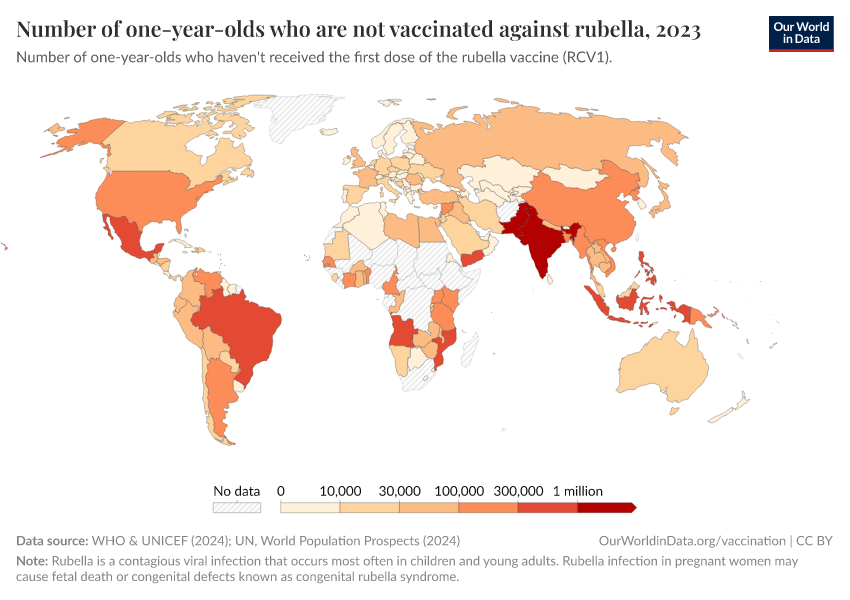Number of one-year-olds who have not been vaccinated against rubella

What you should know about this indicator
- This chart shows official estimates of national immunization coverage published by the WHO and UNICEF. The estimates include all WHO member states, even those that did not report 2023 data. For non-reporting countries, WHO uses statistical methods to extrapolate from previously reported data, ensuring global coverage can be assessed.
- Global and regional vaccination coverage is calculated using population-weighted averages. In 2023, approximately 5% of countries did not report data, requiring extrapolation from their 2022 data to maintain complete global estimates.
- These estimates combine several sources: official administrative data from health facilities, coverage surveys that meet WHO quality standards, and other relevant information like vaccine supply issues or schedule changes. The accuracy of these estimates depends on how complete and reliable each country’s reporting systems are.
- Rubella coverage estimates are based on WHO and UNICEF data for the first dose of the measles-rubella vaccine, as the WHO recommends this combined vaccine.
What you should know about this indicator
- This chart shows official estimates of national immunization coverage published by the WHO and UNICEF. The estimates include all WHO member states, even those that did not report 2023 data. For non-reporting countries, WHO uses statistical methods to extrapolate from previously reported data, ensuring global coverage can be assessed.
- Global and regional vaccination coverage is calculated using population-weighted averages. In 2023, approximately 5% of countries did not report data, requiring extrapolation from their 2022 data to maintain complete global estimates.
- These estimates combine several sources: official administrative data from health facilities, coverage surveys that meet WHO quality standards, and other relevant information like vaccine supply issues or schedule changes. The accuracy of these estimates depends on how complete and reliable each country’s reporting systems are.
- Rubella coverage estimates are based on WHO and UNICEF data for the first dose of the measles-rubella vaccine, as the WHO recommends this combined vaccine.
Sources and processing
This data is based on the following sources
How we process data at Our World in Data
All data and visualizations on Our World in Data rely on data sourced from one or several original data providers. Preparing this original data involves several processing steps. Depending on the data, this can include standardizing country names and world region definitions, converting units, calculating derived indicators such as per capita measures, as well as adding or adapting metadata such as the name or the description given to an indicator.
At the link below you can find a detailed description of the structure of our data pipeline, including links to all the code used to prepare data across Our World in Data.
Reuse this work
- All data produced by third-party providers and made available by Our World in Data are subject to the license terms from the original providers. Our work would not be possible without the data providers we rely on, so we ask you to always cite them appropriately (see below). This is crucial to allow data providers to continue doing their work, enhancing, maintaining and updating valuable data.
- All data, visualizations, and code produced by Our World in Data are completely open access under the Creative Commons BY license. You have the permission to use, distribute, and reproduce these in any medium, provided the source and authors are credited.
Citations
How to cite this page
To cite this page overall, including any descriptions, FAQs or explanations of the data authored by Our World in Data, please use the following citation:
“Data Page: Number of one-year-olds who have not been vaccinated against rubella”, part of the following publication: Fiona Spooner, Saloni Dattani, Samantha Vanderslott, and Max Roser (2022) - “Vaccination”. Data adapted from WHO & UNICEF, United Nations. Retrieved from https://archive.ourworldindata.org/20250929-104429/grapher/rubella-number-unvaccinated.html [online resource] (archived on September 29, 2025).How to cite this data
In-line citationIf you have limited space (e.g. in data visualizations), you can use this abbreviated in-line citation:
WHO & UNICEF (2025); UN, World Population Prospects (2024) – processed by Our World in DataFull citation
WHO & UNICEF (2025); UN, World Population Prospects (2024) – processed by Our World in Data. “Number of one-year-olds who have not been vaccinated against rubella” [dataset]. WHO & UNICEF, “WHO Immunization Data - Vaccination coverage”; United Nations, “World Population Prospects” [original data]. Retrieved December 19, 2025 from https://archive.ourworldindata.org/20250929-104429/grapher/rubella-number-unvaccinated.html (archived on September 29, 2025).